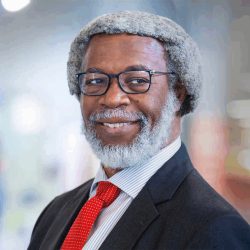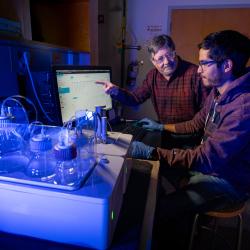Eight College Faculty Members Named 2018 Highly Cited Researchers
Sankar Das Sarma, Daniel Gruner, Mihai Pop, Ian Spielman, Nathan Swenson, Dennis vanEngelsdorp, Chunsheng Wang and Ning Zeng received the honor
Eight faculty members in the University of Maryland’s College of Computer, Mathematical, and Natural Sciences are included on Clarivate Analytics’ 2018 list of Highly Cited Researchers, a compilation of influential names in science.
- Sankar Das Sarma, Richard E. Prange Chair and Distinguished University Professor in Physics, Joint Quantum Institute Fellow, and Condensed Matter Theory Center Director. Das Sarma was included in all previous compilations of this list in 2017, 2016, 2015, 2014 and 2001.
- Daniel Gruner, Associate Professor of Entomology and Program Director for the Division of Environmental Biology at the National Science Foundation
- Mihai Pop, Professor of Computer Science, Director for the University of Maryland Institute for Advanced Computer Studies, Co-director of the Center for Health-related Informatics and Bioimaging. Pop was also included in the 2014 compilation.
- Ian Spielman, Adjunct Professor of Physics, JQI Fellow and National Institute of Standards and Technology (NIST) Fellow. Spielman was also included in the 2017 compilation.
- Nathan Swenson, Professor of Biology
- Dennis vanEngelsdorp, Associate Professor of Entomology and President of the Bee Informed Partnership. VanEngelsdorp was also included in the 2017 and 2016 compilations.
- Chunsheng Wang, Professor of Chemistry and Biochemistry, Professor and Robert Franklin and Frances Riggs Wright Distinguished Chair of Chemical and Biomolecular Engineering, UMD Director of Center for Research in Extreme Batteries
- Ning Zeng, Professor of Atmospheric and Oceanic Science with a joint appointment in the Earth System Science Interdisciplinary Center
Das Sarma’s research interests include condensed matter physics, statistical mechanics and quantum information. A theoretical condensed matter physicist, Das Sarma has worked in the areas of strongly correlated materials, graphene, semiconductor physics, low-dimensional systems, topological matter, quantum Hall effect, nanoscience, spintronics, collective properties of ultra-cold atomic and molecular systems, optical lattice, many-body theory, Majorana fermion, and quantum computation. Das Sarma’s introduction of the nu=5/2 topological qubit in 2005 with Microsoft Research colleagues Chetan Nayak and Michael Freedman, and his 2010 theoretical predictions of special particles called Majorana fermions in semiconductor nanowires have led to experiments in building scalable, fault-tolerant quantum computers based on two-dimensional semiconductor structures or nanowires.
Das Sarma, a physics faculty member at UMD since 1980, earned his undergraduate degree in physics in 1973 from Presidency College in Kolkata, India, and his Ph.D. in theoretical condensed physics in 1979 from Brown University.
Gruner studies insects and plants to explore the dynamic interplay of biodiversity, food web interactions and ecosystem function in rapidly changing environments such as the Hawaiian Islands, Florida mangrove forests and California coastal prairies. In addition, Gruner co-organized a working group that led to the creation of the Nutrient Network, a global research cooperative with over a hundred participants that collects worldwide ecological data on grassy ecosystems. Participants in the Nutrient Network published numerous high-impact papers, including a 2014 study suggesting that allowing animals to graze on grasses may protect biodiversity in grasslands that suffer from man-made excesses of fertilizer. In other work, Gruner’s team established global climate change as the reason that Florida mangroves are expanding north and helped to define the burgeoning field of macrosystems ecology, which is the study of ecological phenomena at regional or continental scales.
Gruner joined UMD in 2007. He earned his A.B. in biology from Hamilton College in Clinton, New York, in 1993 and his Ph.D. in zoology from the University of Hawai‘i at Mānoa in 2004.
Pop studies bioinformatics, with a focus on developing computational algorithms for analyzing biological data from high-throughput techniques such as DNA or RNA sequencing. In 2009, Pop was part of the team that published Bowtie, one of the most commonly used software packages for identifying the genomic location of DNA or RNA sequences generated by high-throughput sequencing. Pop is interested in studying complex microbial communities and led a team in assembling data from the Human Microbiome Project, which seeks to survey the complex microbial communities inhabiting the human body. Pop also co-led a 2014 study that used sequencing of human intestinal microorganisms to identify microorganisms that may trigger diarrheal disease, which is a major cause of childhood mortality in developing countries. In 2017, Pop participated in an international effort to benchmark algorithms used in metagenomics, which is the study of microbial DNA and RNA recovered directly from environmental samples.
Pop joined UMD in 2005. He earned his B.S. in computer science from University Politehnica of Bucharest in Romania in 1994 and his M.S.E. and Ph.D. in computer science from Johns Hopkins University in 1998 and 2000, respectively.
Spielman combines experimental and theoretical techniques to study systems of ultracold atoms, which comprise several hundred to several hundred million atoms at temperatures close to absolute zero. Spielman’s focus is making these systems, which have applications in quantum computing, behave like electrons in conventional materials. For example, he has used lasers to manipulate ultracold atoms into moving like charged particles in a magnetic field. His group made cold atoms analogous to modern spintronic materials—often used in semiconductor devices—by introducing Rashba and Dresselhaus spin-orbit couplings. Spielman’s work also touches on novel charge pumps that use the geometry and topology of quantum states and may lead to high-efficiency electronic devices. Recently, he created a cold-atom analog to the five-dimensional Yang monopole, which could lead to new types of quantum charge pumps.
Spielman joined UMD in 2006. He earned his B.S. in physics and mathematics from the University of Oklahoma in 1998 and his Ph.D. in physics from the California Institute of Technology in 2004.
Swenson investigates the ecology and evolution of trees and forest dynamics in response to global change, on scales ranging from individual species' genomes to entire forest ecosystems. In 2015, Swenson was part of an international team of researchers that published the most extensive study on tree competition to date. The study revealed that wood density, specific leaf area and maximum height affect competition in predictable ways across all forested biomes worldwide. Further, these traits capture trade-offs between growth in the open versus growth under intense competition. The study also reinforced that functional traits can provide a foundation for predicting dynamics and interactions between plant species on Earth. In 2017, Swenson collaborated on a study showing that the growth rate of trees was greater when other trees nearby had different plant defense genes. The research also showed that tree survival was correlated with defense-related gene dissimilarity.
Swenson received his B.A. in biology in 2001 from St. Olaf College, his M.S. in biology from New Mexico State University in 2004, and his Ph.D. in ecology and evolutionary biology from the University of Arizona in 2008.
VanEngelsdorp’s research focuses on using an epidemiological approach to assess honey bee health. His research group is a world leader in the study of major mechanisms responsible for the decline in honey bee health, including an increase in pests and pathogens, poor nutrition due to the loss of natural forage and pesticides applied by both beekeepers and farmers. VanEngelsdorp’s approach is multifaceted, addressing both the etiology of individual bee diseases and the large-scale monitoring of colony health. He is also the founding president of the Bee Informed Partnership Inc., a not for profit dedicated to funding honey bee surveillance systems with the intent of reducing honey bee colony losses. In combination with annual nationwide surveys, the Bee Informed Partnership also works directly with beekeepers to help gather pest and disease data and validate trends in management practices.
VanEngelsdorp joined UMD in 2012. He earned his undergraduate degree in agriculture in 1992 and his master’s degree in environmental biology in 1995 from the University of Guelph in Ontario, Canada, and his Ph.D. from the Pennsylvania State University in 2011.
Wang studies and develops advanced materials for safe high-energy batteries that have applications in renewable energy, consumer electronics, electric vehicles and more. In 2015, Wang invented water-in-salt electrolytes for lithium-ion batteries and zinc-air batteries in collaboration with scientists from the U.S. Army Research Laboratory. These inventions opened a new area of high-voltage aqueous electrochemistry and battery research. In 2018, Wang led a collaboration among UMD, the Army Research Laboratory and the Brookhaven National Laboratory that developed and studied a new material that could triple the energy density of lithium-ion battery electrodes. In another study, Wang led a team in developing a non-flammable, high-voltage lithium-ion electrolyte that allowed the creation of batteries with higher energy storage capacity, more efficiency and better safety than current batteries. Wang also searches for alternatives to lithium-based batteries. Alternatives that he has helped develop include sodium-ion batteries, water-based zinc batteries and magnesium/iodine batteries.
Wang joined UMD in 2007. He earned his B.S in mechanical engineering from Jiamusi University in China in 1982, his M.S. in materials science and engineering from the Harbin Institute of Technology in China in 1988, and his Ph.D. in materials science and engineering from Zhejiang University in China in 1995.
Zeng studies climate change and climate variability by developing models of Earth systems such as deserts, the Amazon rain forest and glaciers during the ice age. He takes a special interest in studying the effects of climate change and climate mitigation and adaptation strategies. Zeng also studies the global carbon cycle, or how carbon moves through Earth systems. An atmospheric model that Zeng co-developed in 2014 showed that intense agricultural practices are powerful enough to alter Earth’s atmosphere at an ever-increasing rate, boosting seasonal changes in atmospheric carbon dioxide to about 15 percent over the past five decades. In 2018, Zeng co-authored a study that used computer modeling to show how wind and solar farms could more than double rainfall in the Sahara desert and increase rainfall in the Sahel, a semi-arid region south of the Sahara, by about 20 inches per year.
Zeng joined UMD in 2001. He earned his B.S. in physics at the University of Science and Technology of China in 1987, his M.S. in astrophysics from the University of Arizona in 1991, and his Ph.D. in atmospheric sciences at the University of Arizona in 1995.
The Highly Cited Researchers list features approximately 6,000 authors—some 4,000 in specific fields and about 2,000 across fields—in 21 science and social science disciplines. The scientists’ published work in their specialty areas or across multiple areas has consistently been judged by their peers to be of particular use and significance. These researchers earned the distinction by writing the greatest numbers of reports officially designated by Essential Science Indicators (ESI) as Highly Cited Papers—ranking among the top 1 percent most cited for their subject field or across multiple fields and year of publication. The 2018 Highly Cited Researchers list is drawn from data contained in the ESI spanning 2006-2016.
The Highly Cited Researchers list is one of several criteria used by the Center for World-Class Universities at Shanghai Jiao Tong University to determine the Academic Ranking of World Universities.
###
Media Relations Contact: Irene Ying, 301-405-5204, zying@umd.edu
University of Maryland
College of Computer, Mathematical, and Natural Sciences
2300 Symons Hall
College Park, MD 20742
www.cmns.umd.edu
@UMDscience
About the College of Computer, Mathematical, and Natural Sciences
The College of Computer, Mathematical, and Natural Sciences at the University of Maryland educates more than 9,000 future scientific leaders in its undergraduate and graduate programs each year. The college’s 10 departments and more than a dozen interdisciplinary research centers foster scientific discovery with annual sponsored research funding exceeding $175 million.







